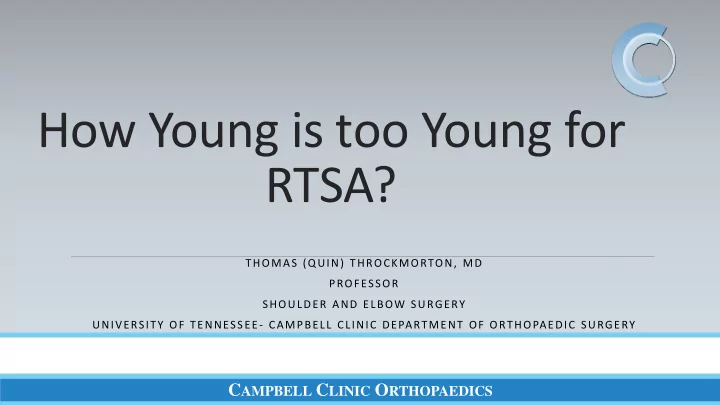

How Young is too Young for RTSA? THOMAS (QUIN) THROCKMORTON, MD PROFESSOR SHOULDER AND ELBOW SURGERY UNIVERSITY OF TENNESSEE- CAMPBELL CLINIC DEPARTMENT OF ORTHOPAEDIC SURGERY C AMPBELL C LINIC O RTHOPAEDICS
I (and/or my co-authors) have something to disclose. Detailed disclosure information is available via: “My Academy” app; Printed Final Program; or My Academy AAOS Orthopaedic Disclosure Program on the AAOS website at http://www.aaos.org/disclosure C AMPBELL C LINIC O RTHOPAEDICS C AMPBELL C LINIC O RTHOPAEDICS
Indications A non-functional rotator cuff ◦ Cuff tear arthropathy ◦ 3 or 4 part proximal humerus fractures ◦ Proximal humerus non-unions ◦ Massive rotator cuff tears with pseudoparalysis ◦ Failed cuff repairs ◦ Tumor resection ◦ Failed shoulder arthroplasty C AMPBELL C LINIC O RTHOPAEDICS
Indications A non-functional rotator cuff ◦ Cuff tear arthropathy ◦ 3 or 4 part proximal humerus fractures ◦ Proximal humerus non-unions ◦ Massive rotator cuff tears with pseudoparalysis ◦ Failed cuff repairs ◦ Tumor resection ◦ Failed shoulder arthroplasty C AMPBELL C LINIC O RTHOPAEDICS
Complications Initially, a reported 50% complication rate and 33% reoperation rate Then 17% complication rate Now 6% Follows experience of other total joint replacements ◦ 87% survival at 15 years Werner CM, JBJS-A, 2005 Frankle MA, JBJS-A, 2006 Cuff D, JBJS-A, 2008 Walch, ASES, 2016 C AMPBELL C LINIC O RTHOPAEDICS
C AMPBELL C LINIC O RTHOPAEDICS
Population Literature focuses on ages 55-65 as cutoff for “young” versus “old” ◦ Does not account for physiologic age One consensus statement placed “minimum” age at 65 for RTSA However, demand projections for shoulder arthroplasty predict a significant increase in patients under 55 ◦ 333% from 2011-2030 Kwaees, Orthop Traumatol Rehabil, 2014 Padegimas, CORR, 2015 C AMPBELL C LINIC O RTHOPAEDICS
Activity Levels Conventional thinking suggests younger patients will be… ◦ More active ◦ Place more stress on components ◦ Have earlier mechanical failure Multiple studies indicate RTSA patients return to medium and high level activity ◦ Includes sporting activities ◦ None of these studies stratified patients by age Lawrence, JSES, 2012 Bulhoff, Arch Orthop Trauma Surg, 2016 Garcia, Am J Sports Med, 2015 Fink-Barnes, Am J Orthop, 2015 C AMPBELL C LINIC O RTHOPAEDICS
Activity Levels Patients under 65 reported similar activity levels as older patients after RTSA ◦ 47% vs 44% high demand activities ◦ 24% vs 37% moderate activities Younger patients more likely to require narcotics and be disabled ◦ Self-regulated their activities to minimize pain and maximize daily functions Walters, JSES, 2016 C AMPBELL C LINIC O RTHOPAEDICS
Outcomes Multiple studies demonstrate satisfactory outcomes in younger patients ◦ Maximum ages vary from 59-65 years ◦ Follow up ranges from 2-15 years ◦ Improved function, pain, and strength ◦ Gains maintained at 10 years in one study Muh, JBJS, 2013 Samuelsen, JSES, 2016 Sershon, JSES, 2014 Dillon, JSES, 2013 Ek, JSES, 2013 C AMPBELL C LINIC O RTHOPAEDICS
Outcomes Inferior patient satisfaction ◦ 81% vs 90-96% 75% satisfactory results by ASES score 38% complication rate reported Higher revision rate ◦ Relative risk 3.0 vs older patients ◦ 25% at average 93 months follow up Muh, JBJS, 2013 Sershon, JSES, 2014 Dillon, JSES, 2013 Ek, JSES, 2013 C AMPBELL C LINIC O RTHOPAEDICS
Why? This is a revision population ◦ 67-83% of patients with at least one prior operation ◦ 46% with muliple prior operations ◦ Average of 2.5 prior operations Muh, JBJS, 2013 Sershon, JSES, 2014 C AMPBELL C LINIC O RTHOPAEDICS
Salvage Similar outcomes for RTSA after failed prior arthroplasty ◦ Improved pain and function ◦ VAS 1.4 SSV 60% ◦ Worse than age matched patients undergoing primary RTSA ◦ Complication rate 28% Black, JSES, 2014 C AMPBELL C LINIC O RTHOPAEDICS
Conclusions RTSA in younger patients is a viable treatment option ◦ More difficult population ◦ Higher revision and complication rates ◦ Limited goals Younger patients not necessarily more active after RTSA ◦ Due to salvage nature of their condition ◦ Self-regulation of activities Long-term outcomes still in process ◦ Mechanical failure still a concern over time C AMPBELL C LINIC O RTHOPAEDICS
Conclusions How young is too young… Combine understanding of… ◦ Pathology ◦ Physiologic age ◦ Activity level ◦ Comfort with revision surgery C AMPBELL C LINIC O RTHOPAEDICS
Thank You C AMPBELL C LINIC O RTHOPAEDICS
Recommend
More recommend